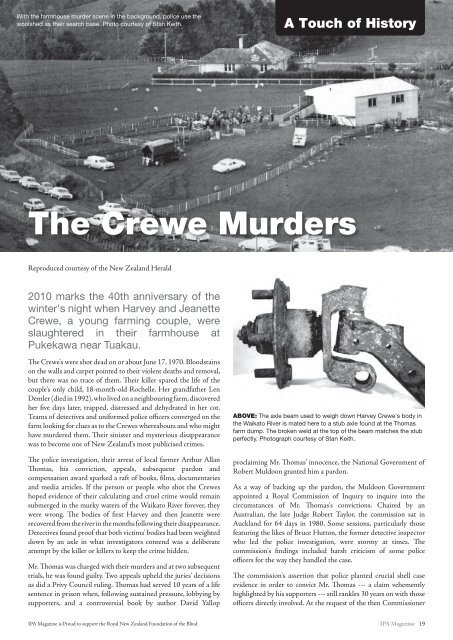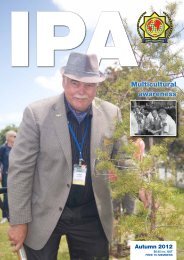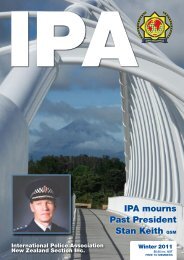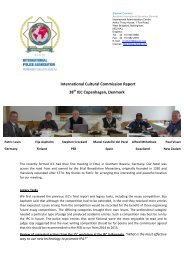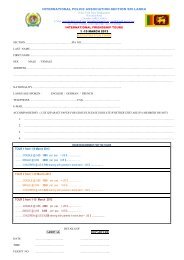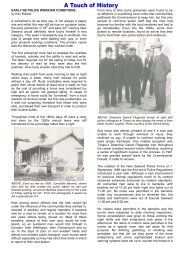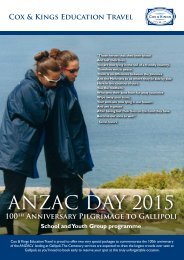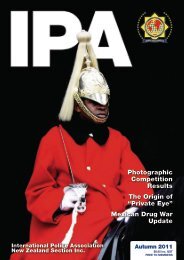The Crewe Murders - Ipa.org.nz
The Crewe Murders - Ipa.org.nz
The Crewe Murders - Ipa.org.nz
You also want an ePaper? Increase the reach of your titles
YUMPU automatically turns print PDFs into web optimized ePapers that Google loves.
With the farmhouse murder scene in the background, police use the<br />
woolshed as their search base. Photo courtesy of Stan Keith.<br />
A Touch of History<br />
<strong>The</strong> <strong>Crewe</strong> <strong>Murders</strong><br />
Reproduced courtesy of the New Zealand Herald<br />
2010 marks the 40th anniversary of the<br />
winter's night when Harvey and Jeanette<br />
<strong>Crewe</strong>, a young farming couple, were<br />
slaughtered in their farmhouse at<br />
Pukekawa near Tuakau.<br />
<strong>The</strong> <strong>Crewe</strong>'s were shot dead on or about June 17, 1970. Bloodstains<br />
on the walls and carpet pointed to their violent deaths and removal,<br />
but there was no trace of them. <strong>The</strong>ir killer spared the life of the<br />
couple's only child, 18-month-old Rochelle. Her grandfather Len<br />
Demler (died in 1992), who lived on a neighbouring farm, discovered<br />
her five days later, trapped, distressed and dehydrated in her cot.<br />
Teams of detectives and uniformed police officers converged on the<br />
farm looking for clues as to the <strong>Crewe</strong>s whereabouts and who might<br />
have murdered them. <strong>The</strong>ir sinister and mysterious disappearance<br />
was to become one of New Zealand's most publicised crimes.<br />
<strong>The</strong> police investigation, their arrest of local farmer Arthur Allan<br />
Thomas, his conviction, appeals, subsequent pardon and<br />
compensation award sparked a raft of books, films, documentaries<br />
and media articles. If the person or people who shot the <strong>Crewe</strong>s<br />
hoped evidence of their calculating and cruel crime would remain<br />
submerged in the murky waters of the Waikato River forever, they<br />
were wrong. <strong>The</strong> bodies of first Harvey and then Jeanette were<br />
recovered from the river in the months following their disappearance.<br />
Detectives found proof that both victims' bodies had been weighted<br />
down by an axle in what investigators contend was a deliberate<br />
attempt by the killer or killers to keep the crime hidden.<br />
Mr. Thomas was charged with their murders and at two subsequent<br />
trials, he was found guilty. Two appeals upheld the juries' decisions<br />
as did a Privy Council ruling. Thomas had served 10 years of a life<br />
sentence in prison when, following sustained pressure, lobbying by<br />
supporters, and a controversial book by author David Yallop<br />
ABOVE: <strong>The</strong> axle beam used to weigh down Harvey <strong>Crewe</strong>'s body in<br />
the Waikato River is mated here to a stub axle found at the Thomas<br />
farm dump. <strong>The</strong> broken weld at the top of the beam matches the stub<br />
perfectly. Photograph courtesy of Stan Keith.<br />
proclaiming Mr. Thomas' innocence, the National Government of<br />
Robert Muldoon granted him a pardon.<br />
As a way of backing up the pardon, the Muldoon Government<br />
appointed a Royal Commission of Inquiry to inquire into the<br />
circumstances of Mr. Thomas's convictions. Chaired by an<br />
Australian, the late Judge Robert Taylor, the commission sat in<br />
Auckland for 64 days in 1980. Some sessions, particularly those<br />
featuring the likes of Bruce Hutton, the former detective inspector<br />
who led the police investigation, were stormy at times. <strong>The</strong><br />
commission's findings included harsh criticism of some police<br />
officers for the way they handled the case.<br />
<strong>The</strong> commission's assertion that police planted crucial shell case<br />
evidence in order to convict Mr. Thomas --- a claim vehemently<br />
highlighted by his supporters --- still rankles 30 years on with those<br />
officers directly involved. At the request of the then Commissioner<br />
IPA Magazine is Proud to support the Royal New Zealand Foundation of the Blind IPA Magazine 19
ABOVE: RNZAF barge 312, dubbed the 'River Queen' by police, was<br />
rigged with a generator and winch to operate an electro magnet for<br />
the river search.<br />
of Police, the late Bob Walton, the Solicitor-General Paul Neazor<br />
conducted an investigation as whether Mr. Hutton should be<br />
prosecuted for his part in the <strong>Crewe</strong> murder investigation. In a<br />
confidential report presented to Mr. Walton in 1981, Mr. Neazor<br />
found a prosecution against Mr. Hutton could not be justified<br />
because there was no evidence to support such a move. Mr. Walton<br />
told Mr. Hutton by telephone that he had been cleared but it was<br />
not until May last year that he received a written copy.<br />
Mr. Walton and Ken Thompson, the officer who succeeded him as<br />
Police Commissioner, both interviewed members of the police team<br />
who investigated the murders. <strong>The</strong>y concluded there was no<br />
evidence to take the case further hence police took no further action.<br />
In spite of proffered submissions over the years of names of suspects,<br />
the culprit or culprits responsible for the <strong>Crewe</strong> slayings have not<br />
been arrested.<br />
An air of mistrust pervaded the Royal Commission of Inquiry<br />
hearings into the convictions of Arthur Allan Thomas in Auckland<br />
in 1980. Senior police officers and Crown lawyers were so concerned<br />
their backroom conversations would be monitored by the<br />
Commission they called on the Security Intelligence Service for<br />
back up. Each morning for the 64 days the Commission sat in<br />
Downtown Auckland, SIS agents with eavesdropping detection<br />
equipment swept rooms used by police and lawyers assigned to<br />
assist the Commission but they found no bugs. <strong>The</strong> mere fact they<br />
looked for them was a strong indication some Government agents<br />
were highly suspicious of the commission, one appointed by the<br />
National Government of Prime Minister Robert Muldoon, and its<br />
motives.<br />
Bruce Hutton now aged 81 and living in quiet retirement in South<br />
Auckland, rarely speaks publicly of his experience with the case, the<br />
most memorable of his career. He likened his treatment by<br />
Commission chairman Judge Taylor to an inquisition. "We never<br />
saw eye to eye," said Mr. Hutton. "When I got into the [witness]<br />
box, he attacked me for showing the jury the blood stained carpet.<br />
He knew I knew that that is what the prosecution is for, to show the<br />
jury what happened by photographs. What the prosecutor wanted<br />
to show was the way the body had been dragged, the blood trail. He<br />
started getting stuck into me and that happened a number of times<br />
between Taylor and I."<br />
While Mr. Hutton admits 40 years on that the aftermath of the<br />
<strong>Crewe</strong> murder investigation had caused him some strain in his<br />
personal life, he said: "I didn't lose any sleep at any stage." He tells<br />
how the former Governor General, the late Sir David Beattie, had<br />
20 IPA Magazine<br />
ABOVE: Police searching the banks of the Waikato River still swollen<br />
by heavy rain. It was in a vessel like this that Constable Gerry Wylie of<br />
Tuakau found an old kitchen chair in the river. For a bit of humour he<br />
sat on it in the boat and discovered he could see much deeper into<br />
the water. Because of this he subsequently found Harvey <strong>Crewe</strong>'s<br />
body some three months after his murder.<br />
ABOVE: When the swollen river waters subsided, Jeanette <strong>Crewe</strong>'s<br />
body was discovered at Devil's Elbow two months after the scene was<br />
discovered. Photograph courtesy of the NZ Herald.<br />
taken him aside in the president's room at the Trentham racecourse<br />
and said: "Bruce, I just want you to know that having to sign that<br />
pardon for Thomas was the hardest thing I've ever had to do in my<br />
life. I just want you to know that Muldoon insisted." <strong>The</strong> pair knew<br />
each other from their days in Auckland when Sir David was a lawyer<br />
and Mr. Hutton a police prosecutor.<br />
Mr. Hutton said the late Sir Tom Skinner, the former Federation of<br />
Labour president, had approached him in a restaurant before Mr.<br />
Thomas was granted a pardon. Sir Tom said Mr. Muldoon had<br />
confided the pardon was in the pipeline to the Governor General.<br />
Mr. Hutton said: "Sir Tom said 'Muldoon told me that Cabinet<br />
wouldn't go along with it but he was going to do it on his own'."<br />
ABOVE: In addition to the river, extensive searches were <strong>org</strong>anised of<br />
the surrounding farmland. One of the biggest searches in NZ Police<br />
history it was planned and coordinated by Inspector Pat Gaines.
Asked how he felt in the wake of the trials, appeals, the ultimate<br />
pardon of Mr. Thomas and the Royal Commission's report, Mr.<br />
Hutton said: "I just feel the way it was handled was very unfair to<br />
the Crown, the police and me and to [the late detective] Len<br />
Johnston in particular. [<strong>The</strong> Royal Commission was critical of Mr.<br />
Johnston's role in the recovery of two stub axles said to be evidence<br />
in the case.] "As far as I am concerned, the police and me, those<br />
involved, did their job and took the case to two trials on the evidence<br />
that had been discovered."<br />
Of Mr. Johnston, who died before the Royal Commission sat, Mr.<br />
Hutton said: "I was rather surprised the commission criticised him<br />
without making any inquiries into the detective's previous service or<br />
background, that he was a very honest, straight forward detective."<br />
Does Mr. Hutton have any regrets about the case? "Regrets as far as<br />
what the commission did, yes. Apart from that, no." Mr. Hutton<br />
regards the killings at Pukekawa, a small farming settlement near<br />
Tuakau, as one of the most callous he ever had to investigate. In his<br />
view, Harvey and Jeanette <strong>Crewe</strong> did not deserve to die the way<br />
they did. <strong>The</strong>ir deaths were made more heartless by the way their<br />
toddler, Rochelle, was left abandoned in cot for five days until<br />
maternal grandfather Len Demler discovered her five days later on<br />
June 22, 1970. Rochelle's eyes were sunken. "She'd been chewing on<br />
wet nappies for sustenance," he said. "To me, that's showing<br />
desperation by the child to survive?.and biting all the varnish off the<br />
top of its cot trying to get nourishment."<br />
ABOVE: Detective Inspector Bruce Hutton sits in the armchair in<br />
which Harvey <strong>Crewe</strong> was shot to help recreate his theory of how the<br />
shooting occurred. Photograph courtesy of Alan Arnold.<br />
Her physical state was a puzzle. Medical experts gave conflicting<br />
views about whether or not she'd been fed. "In my opinion, from<br />
what I saw, no way was that child fed. No way." Mr. Hutton said.<br />
"Why did it suck its wet nappy until it got sores in its mouth and<br />
that? I don't think that child was ever fed. <strong>The</strong> child was weak.<br />
Surely if you are going to feed a child you are going to give it<br />
sufficient nourishment to keep it alright?<br />
Initially, Mr. Hutton thought police were faced with solving a<br />
murder suicide case and that somebody had buried the bodies,<br />
hence a massive search of the <strong>Crewe</strong> and Demler properties. Mr.<br />
Demler, who died in 1992, was initially one of those on a list of<br />
suspects for the murders but was cleared from police suspicion after<br />
the <strong>Crewe</strong> bodies recovered from the Waikato River showed they<br />
had been shot with a gun Mr. Demler did not possess.<br />
Of criticism over the years of his decision to dump <strong>Crewe</strong> murder<br />
exhibits, such as a vital shell case, in the Whitford tip, Mr. Hutton<br />
said: "As far as I am concerned, I did what I normally would do.<br />
That [destruction of exhibits] was our procedure and I was<br />
constantly being pressured by Detective Superintendent [Mal]<br />
Ross on his monthly inspections to dispose of exhibits in view of no<br />
further pending action ever to be taken in the <strong>Crewe</strong> case. We had a<br />
garage downstairs, a single garage [at Otahuhu police station] and<br />
stuff was jammed in there. <strong>The</strong>re was no room for it. After that final<br />
appeal [involving Arthur Allan Thomas], he [Ross] said 'That's it'."<br />
ABOVE: Crown Solicitor David Morris QC stands outside the <strong>Crewe</strong><br />
house in the position from which the fatal shot was believed to have<br />
been fired through the open louvre windows.<br />
ABOVE: <strong>The</strong> legal team. Back Row: Alan Arnold, Graham ‘Bud’<br />
Abbott, Mike Charles and Stan Keith. Front Row: Len Johnson, David<br />
Morris QC, Bruce Hutton and David Baragwanath.<br />
Mr. Hutton retired from the police in 1976. He's adamant his<br />
decision to leave was not influenced by the <strong>Crewe</strong> murder case. "I<br />
always said I wasn't there for the long haul, that I wanted to go back<br />
farming and have a go at breeding horses," he said. "I'd previously<br />
been farming right from my childhood days."<br />
For former detective Stan Keith, involvement in the <strong>Crewe</strong> murder<br />
case and its ramifications, legal and otherwise, still continues. Since<br />
Mr. Hutton's retirement from the police, Mr. Keith has been<br />
designated as the "minder" of the 29 boxes of <strong>Crewe</strong> murder files<br />
held in Police National Headquarters archives.<br />
When a politician, author, journalist or member of the public seeks<br />
information on the case, Mr. Keith has been the one assigned to<br />
seek answers. <strong>The</strong>ir questions have resulted in him having to make<br />
countless trips to Wellington to sift through the myriad of<br />
information.<br />
IPA Magazine is Proud to support the Royal New Zealand Foundation of the Blind IPA Magazine 21
"It has been my life," said 69-year-old Mr. Keith who retired from<br />
the police with the rank of detective inspector in 1995. "If it hadn't<br />
been for this inquiry, I would have chased promotion within the<br />
police. You get politicians, you get ghouls, you get journalists who<br />
want to write books and you get those who want to do films. You get<br />
heaps and heaps of correspondence that comes through from<br />
headquarters. I've had enough of it and I've told them so."<br />
Mr. Keith was assigned to the <strong>Crewe</strong> murder investigation within<br />
hours of the discovery of the blood-spattered farm house. He<br />
remembers Mr. Walton visiting the Pukekawa crime scene and<br />
telling him: "Son, you only get one of these inquiries in your<br />
lifetime."<br />
Asked if he thought Rochelle <strong>Crewe</strong> had been fed, cleaned or both<br />
before her grandfather found her in her cot, Mr. Keith said: "<strong>The</strong><br />
question I have asked is 'How long would a baby survive in a cot on<br />
its own in winter?' <strong>The</strong>n you have a sighting of a woman outside the<br />
little gate at the house during the day. <strong>The</strong> <strong>Crewe</strong>'s had a green<br />
coloured car. When the sighting of the car was made on Saturday<br />
[ June 19, 1970], the witness assumed it was the <strong>Crewe</strong> car. But it<br />
[the <strong>Crewe</strong> car] was parked in the garage out of sight, so it was<br />
someone else's. When an examination of the house was done, there<br />
were two saucepans in the kitchen. One of them had Harvey’s<br />
diluted blood in the saucepan and the second one had Jeanette's<br />
blood group. If one person went back, you would grab a saucepan<br />
and clean up the blood. It gives an indication of two people [being<br />
present]."<br />
Mr. Keith was assigned to attend the 1980 Royal Commission<br />
hearings and provide Judge Taylor and his fellow commissioners<br />
with any police material they wanted. He told the Herald: "Police<br />
had concerns during the hearings that their discussions about the<br />
case might be monitored. <strong>The</strong>y were worried their conversations<br />
would have been used by the commission. <strong>The</strong> Security Intelligence<br />
Service used to arrange for the police room where the Crown<br />
solicitors worked to be debugged every morning. It was to protect<br />
us and our conversations. <strong>The</strong>y used to bring in equipment and do<br />
their checks. <strong>The</strong>y never found anything. Brian Wilkinson [the late<br />
former Detective Superintendent] arranged it."<br />
Did Mr. Keith have sympathy for former colleague Mr. Hutton? "I<br />
felt sorry for him, the flak he took from the retrial committee in the<br />
early years and later on, as you know, he shut up," said Mr. Keith. "I<br />
think he was a great loss to the department."<br />
Mike Charles, who is semi-retired and living Palmerston North,<br />
was a detective sergeant in Auckland when directed to join the<br />
Pukekawa team. One of his first duties was to take baby Rochelle to<br />
visit two Auckland medical specialists for them to establish if she'd<br />
been fed in the previous five days. Mr. Charles recalled how Rochelle<br />
clung "like a monkey" to the neck and waist of a woman family<br />
friend acting as her foster mother. While the two doctors could not<br />
agree she had been fed, Mr. Charles believes Rochelle looked well<br />
nourished. "She was obviously a well cared for baby," he said. "<strong>The</strong><br />
thing I feel disappointed about was that in the early days we<br />
concentrated on the father as the suspect and we got tunnel vision.<br />
We did not have the bodies then. Len Demler became very focused<br />
as the suspect when, in hindsight, we were wrong. <strong>The</strong>y [the <strong>Crewe</strong>s]<br />
had been killed with a .22 calibre rifle to which Len did not have<br />
access."<br />
It was Mr. Charles and his colleague Detective Sergeant Bruce<br />
Parkes who found a shell cartridge case in a renewed, more detailed<br />
search of a flower bed near the <strong>Crewe</strong> homestead four months after<br />
the murders. He totally refutes a repeated claim over the years that<br />
22 IPA Magazine<br />
the shell case had been planted by police. <strong>The</strong> condition of the shell<br />
case and the fact that he was one of two people sent to find it<br />
convinced him he had found genuine evidence. "I have never lost<br />
any sleep that it was a genuine find. I believe it was a shell case<br />
dropped by the killer," he said.<br />
Mr. Charles regards the <strong>Crewe</strong> murders as a callous and calculated<br />
act because of the way the two bodies were disposed of in an obvious<br />
bid to conceal how they were killed. And he believes three separate<br />
incidents on the <strong>Crewe</strong> farm in the months leading up to the June<br />
murders could well be connected to the killings --- a fire in a hay<br />
barn and two burglaries at their home. One aspect of the Pukekawa<br />
saga disappointed Mr. Charles. He was denied his request to keep<br />
the shell case he found as a souvenir. He believes dumping the shell<br />
case was the wrong thing to do because its destruction meant it was<br />
no longer available for expert examination.<br />
ABOVE: Detective Inspector Bruce Hutton at his desk with his<br />
Certificate of Appreciation received for his work on the <strong>Crewe</strong> murder<br />
enquiry. Photo courtesy of Stan Keith.<br />
Rochelle moved to the United States to live with her mother's sister,<br />
Heather, in the wake of the murders. Police investigators heard<br />
occasional progress reports of Rochelle as she grew up. In recent<br />
years, they learned Rochelle had returned to New Zealand to live.<br />
Mr. Charles said he'd been told Rochelle now had two children of<br />
her own, lived in the South Island and wanted nothing to do with<br />
what happened to her parents so tragically 40 years ago.<br />
EDITOR's NOTE: This was one of three significant and groundbreaking murder<br />
investigations to occur in this area of South Auckland. In 1920 Sydney Seymour<br />
Eyre was murdered at Pukekawa and this was the first time a police car is<br />
recorded to have transported investigating police to a crime scene. In October<br />
1933 Christobel and Samuel Lakey were murdered at Ruawaro. That<br />
investigation utilised aerial search and aerial photography for the first time. <strong>The</strong><br />
<strong>Crewe</strong> murders of 1970 saw the first use of police divers in an investigation and<br />
the largest ground and water search experienced up to that time.


